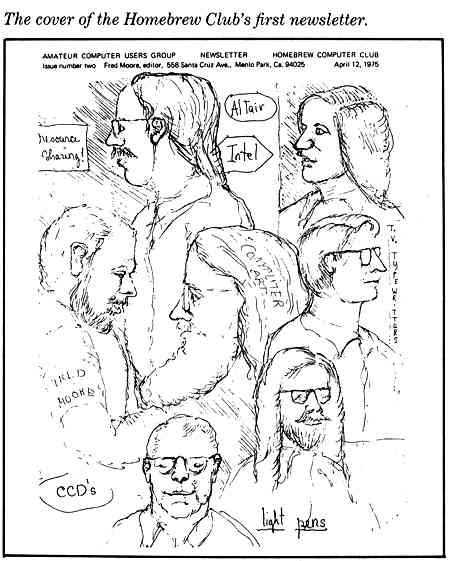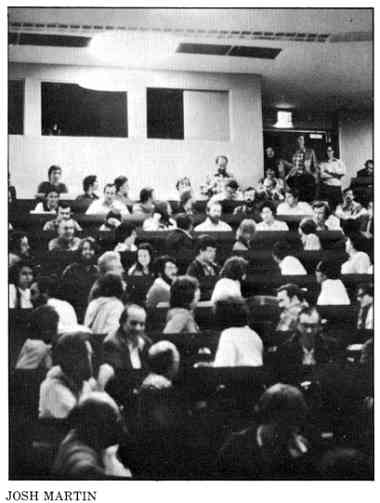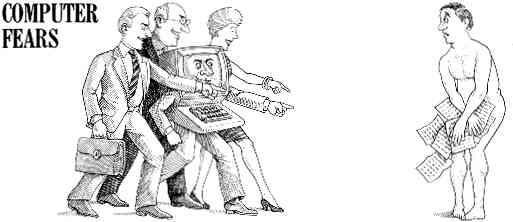HOW THE APPLE
CAME TO BE
by Stephen Wozniak
Stephen Wozniak is the designer of the Apple II computer and cofounder of Apple Computer Inc.
Without computer clubs there would probably be no Apple computers. Our club in the Silicon Valley, the Homebrew Computer Club, was among the first of its kind. It was in early 1975, and a lot of tech-type people would gather and trade integrated circuits back and forth. You could have called it Chips and Dips. We had similar interests and we were there to help other people, but we weren't official and we weren't formal. Our leader, Lee Felsenstein, who later designed the Osborne computer, would get up at every meeting and announce the convening of "the Homebrew Computer Club which does not exist" and everyone would applaud happily.
The theme of the club was "Give to help others." Each session began with a "mapping period," when people would get up one by one and speak about some item of interest, a rumor, and have a discussion. Somebody would say, "I've got a new part," or somebody else would say he had some new data or ask if anybody had a certain kind of teletype.
During the "random access period" that followed, you would wander outside and find people trading devices or information and helping each other. Occasionally one guy would show up and say, "Is there anyone here from Intel? No? Well, I've got some Intel chips we want to raffle off." This was before big personal computer firms and big money considerations. There was just one personal computer then, the Altair 8800, based around the Intel 8080 microprocessor.
The Apple I and II were designed strictly on a hobby, for-fun basis, not to be a product for a company. They were meant to bring down to the club and put on the table during the random access period and demonstrate: Look at this, it uses very few chips. It's got a video screen. You can type stuff on it. Personal computer keyboards and video screens were not well established then. There was a lot of showing off to other members of the club. Schematics of the Apple I were passed around freely, and I'd even go over to people's houses and help them build their own.

The Apple I and Apple II computers were shown off
every two weeks at the club meeting. "Here's the latest little
feature," we'd say. We'd get some positive feedback going and turn
people on. It's very motivating for a creator to be able to show what's
being created as it goes on. It's unusual for one of the most
successful products of all time, like the Apple II, to be demonstrated
throughout its development.
Today it's pretty obvious that if you're going to
build a billion-dollar product, you have to keep it secret while it's
in development because a million people will try to steal it. If we'd
been intent on starting a company and selling our product, we'd
probably have sat down and said, "Well, we have to choose the right
microprocessor, the right number of characters on the screen," etc. All
these decisions were being made by other companies, and our computer
would have wound up being like theirs-a big square box with switches
and lights, no video terminal built in . . .
We had to be more pragmatic. The 6502
microprocessor, for instance, was chosen for one reason only. It was
the first one to sell over the counter for $20. The 8080 cost $370 at
the time, and you couldn't get it at any surplus stores. You had to go
down to a distributor, and they made you feel like you had to be a
company with an account. It wasn't set up for hobbyists or
experimenters.
Apple Seedlings
Steve Jobs was a friend of mine from high school. We were introduced
because we had two things in common: electronics and pranks. It turned
out that he had a tremendous drive to start a company. He had worked at
Atari and had become friends with some of the key people there,
including Nolan Bushnell, the founder. Nolan was his idol. Steve wanted
to have a successful product, go out and start selling it, and make
some money. He also had excellent product ideas for the upcoming home
personal computer.
To produce the Apple I, Steve and I formed a
partnership. We didn't sell very many Apple Is the first year. We built
them at night in our garage. At first we expected to sell circuit
boards at the Homebrew Club: just put in your own chips and it'll work.
Then we got a $50,000 order from a local store and we were in heaven.
The trouble was how to get the money to build a
hundred computers-they might cost over a hundred dollars each to build.
Steve went to a local parts supplier and talked them into giving us a
lot of parts on thirty days' net credit. It was very unusual for them
to give us credit, because we didn't own anything. We didn't own
houses. We didn't even own our cars. But Steve is very persuasive. We'd
get the parts and then stuff them into the circuit boards, have them
soldered, get them back in the garage and test them. And we could turn
the whole cycle around in ten days and get paid. It worked really great
because we had only one level of management.
We got our names established. The computer magazines
started carrying lists of all the microcomputers coming out, and they'd
describe all the characteristics-how much memory, which processor, was
it assembled or was it a kit, what was its price. The Apple I had a
good appearance, and we were always at the top of the lists because
they were in alphabetical order.
After the Apple I was out, we tried to add new
features. We thought about color and maybe some high-resolution
graphics. I found ways to optimize and combine different parts of the
circuits and make things with fewer chips. It's great to show off at a
club that you use fewer chips than someone else. I did it for no other
reason.
The Apple II came out of trying to improve the Apple
I. From thinking out a way to make it with half as many chips, you
could have a much better product. It was faster, it had color, it had
high-resolution graphics, it had mixed modes on the screen with text. A
lot of neat features made it look like this might be a nifty product.
It turns out that some of its best features were inspired by what
little experience we had.
Steve and I had done a game for Atari-Breakout for
the arcades-before games were on microprocessors. We were running the
Apple II down at the Homebrew Club, so I thought it would be neat if
you could write Breakout in BASIC. I added graphics mode commands to
the Integer BASIC I was writing. Breakout needs paddles: I had to add a
little circuitry for paddle and push button. You need sound: when the
ball hits the bricks, ping; when you lose, ehhhh. So I put a speaker
in. All of these features were basically just to play one game.
These turned out to be common features for the
personal computers that have come out since that time. We weren't quite
the first to offer a keyboard and video output, but we were close. We
were the first to offer built-in BASIC. We made the first built-in
cassette port so you could use a cheap cassette recorder to load your
programs in and store them. We had started to set standards for what
have come to be known as low-cost personal computers.
Just about the only argument on product design Steve
and I ever had was on the number of expansion slots. I wanted eight and
he wanted two. I was for eight simply because I'd been around
minicomputers that had a lot of extra function boards plugged in. Steve
figured people would only use maybe a printer and a modem, and that was
it. Fortunately we went with eight, because the Apple II's
expandability was important to its success.
When we geared up to manufacture the Apple II, it
looked like I'd have to leave my nice secure job at Hewlett-Packard. I
thought about it and said no. I just loved going down to the Homebrew
Computer Club, showing off my ideas and designing neat computers. I was
willing to do that for free for the rest of my life. Steve got
extremely anxious. He got all my friends and relatives to start phoning
and tell me why I was making a mistake. Finally one of them called and
said you can start a company, remain an engineer and also get rich. I
decided that you can start a company and make money. Once I got the
consciousness right, it was easy to quit HP and take this big risk.
We got our first ad agency and began discussing who
we were and what our product was and how we would market it. Of course,
to a marketer Apple was an odd name. It came from the days when you
picked an interesting, fun name for a company. You do that when you're
on a hobby basis. The ad agency kept telling us the name had to be
changed. We had to have a name that suggested technology, number
crunching, calculations, data bases. We took the attitude that Apple is
a good name. Our computer would be friendly-everything an apple
represents, healthy, personal, in the home. We had to hold our ground
on that one. The agency designed our color logo. (Our original logo was
Newton under the apple tree.) Steve twiddled the colors around and kept
a rainbow orientation.
| COMPUTER GROUP GUIDE One of the most complete listings of user groups can be found in the annual Classroom Computer News Directory. Originally intended for teachers, this 200-page directory provides a wealth of information for general users on all aspects of computing, including sets of guidelines for hardware and software selection as well as a complete Yellow Pages of computer services and products. The directory is available from Classroom Computer News, 341 Mt. Auburn St., Watertown, MA 02172. Telephone: (617) 923-8595.  |
Core Memory
We introduced the Apple II at the First West Coast Computer Faire. The first computer shows were informal, not like the professionally oriented shows we have today. They were more an outgrowth of computer clubs. We got a lot of our initial support from these clubs. I started speaking at them whenever I was invited, and I've been doing it from that day on. I travel at my own expense because I think it's exciting to tell the story of how our company sprang up from a club.
Our success was due to a number of factors. First of all, we had never manufactured computers before. We couldn't look back and say, "Here's how computers earned a lot of money in the sixties and seventies, that's the style to do." All we thought about was what was going to work out great in our own homes. Our motivation was what would be good in the end. If there was a known formula for what would make a successful product, and what would make a billion dollars, all the big companies would have jumped on it. All these companies were a lot smarter than us. What we had was luck. We did the right things with the right coincidences of timing and the right people in the right place.
We had a lot of interest and enthusiasm. The rewards that drove us were all intrinsic. The computers were being put together to show off at a computer club: "Look at this. I put in these neat commands." It's not like you get a better salary, or a better title, or more respect at work, or a new car. We had the autonomy of creators. We could decide what was going to make a neat computer. We could implement it, and we could show it off. We also had excellent feedback from our peers.
Back then, the small computer scene was based on the belief that we were all on top of a revolution. Everyone attending the club in 1975-76 knew there was a big computer revolution occurring and the rest of the world wasn't aware of it yet. That's why there was so much excitement and spirit. We were finally going to get control of our own computers. It wasn't a million-dollar thing that belonged to the company you worked for. This big thing that had so much value, and that we wanted to use and control, we finally were getting close to. Look at how many companies have sprung out of our Homebrew Computer Club. At last count, it was something like twenty-one! We managed to bring the computer revolution home.

GEORGE S. ZARR, JR., Renaissance man and computer professional |
Return to Table of Contents | Previous Article | Next Article

